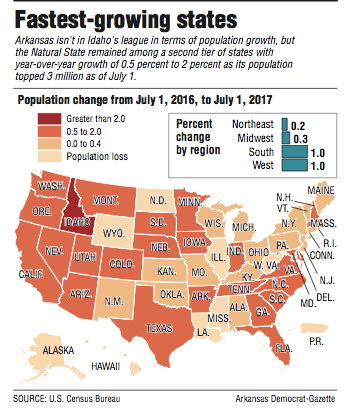Arkansas' population topped 3 million this year for the first time in its 181-year history, the U.S. Census Bureau reported this week.
Though the state population is growing, its year-to-year growth of 0.5 percent was lower than the national average of 0.7 percent.
The Natural State's population climbed 16,048 in one year's time -- from 2,988,231 on July 1, 2016, to 3,004,279 on July 1, 2017, according to census estimates.
Overall, 42 states and the District of Columbia grew in population while eight saw population drops.
Arkansas remains the nation's 32nd-largest state, unchanged from last year.
Elected officials welcomed the latest signs of growth.
"The census report is another confirmation that life in Arkansas is good and getting better," Gov. Asa Hutchinson said in a written statement. "Many Arkansas companies are expanding, and we continue to attract new business from across the nation and from other countries."
Arkansas' unemployment rate earlier this year was the lowest ever recorded in the state, dropping to 3.4 percent. In October, it stood at 3.6 percent. The national figure for that month was 4.1 percent.
Meeting with reporters Thursday, Hutchinson said he was "delighted" to see the state reach the population milestone.
"This is one of the results of a growing economy, and that's been the focus that we have had," he said. "It shows that there is job creation and that's attracting people to our state."
Roughly half of Arkansas' population change was because of a "natural increase," according to the census. Births outnumbered deaths, 38,236 to 30,395, a difference of 7,841.
The rest of the population increase -- 8,217-- was a result of net migration. Of those, 4,718 came from other states, and 3,499 was the result of international migration.
(The total that the government reported for natural increases and net migrations differs slightly from the total reported for state population growth).
Arkansas' population grew more rapidly than all but two of its neighboring states.
Texas and Tennessee surpassed the national average, while Mississippi and Louisiana had population decreases.
The others had slight increases: Oklahoma (0.2 percent); Missouri (0.4 percent).
Graham Cobb, president and chief executive of the Greater Bentonville Chamber of Commerce, said his corner of the state remains attractive to outsiders.
"With a low cost of living and a high quality of life, I'm not surprised to see it growing," he said. "The Northwest Arkansas economy has been diverse and robust for years, decades," he said. "This is a sign that things are continuing to move in the right direction."
The nation's estimated population stood at 325.7 million on July 1, an increase of 2.3 million. The Northeast saw sluggish growth (0.2 percent) as did the Midwest (0.3) percent. The South and the West continued to outpace the nation as a whole. Both regions grew 1 percent.
Similar population estimates for the nation's cities, counties and towns are scheduled to be released next year.
Barring a drastic shift in population, Arkansas will continue to have four seats in the U.S. House of Representatives after the 2020 census.
The nation's most populous state remains California, with 39.5 million residents' followed by Texas at 28.3 million; and Florida with 20.98 million; New York with 19.8 million; Pennsylvania with 12.8 million; and Illinois with 12.8 million.
The states with the biggest population growth were all in the South and the West. Texas gained 399,734 residents; Florida 327,811; California 240,177; Washington state 124,809; North Carolina 116,730; Georgia 115,759; and Arizona 107,628.
The areas with the highest percentage growth were Idaho at 2.2 percent; Nevada 2.0 percent; Utah 1.9 percent; Washington 1.7 percent; Florida 1.6 percent; Arizona 1.6 percent; and Texas, the District of Columbia, Colorado and Oregon at 1.4 percent.
Different factors fueled growth in these states, the Census Bureau said in a news release.
"Domestic migration drove change in the two fastest-growing states, Idaho and Nevada, while an excess of births over deaths played a major part in the growth of the third fastest-growing state, Utah," said Luke Rogers, who leads the bureau's population estimates branch.
Nationwide, there were 3.9 million births and 2.7 million deaths during the period. In Utah, by comparison, there were 51,461 births and only 16,575 deaths.
Information for this article was contributed by Michael R. Wickline of the Arkansas Democrat-Gazette.
A Section on 12/22/2017
